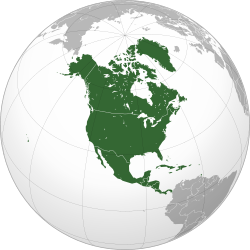Curaçao
Curaçao (/ˈkjʊərəsoʊ, -saʊ, ˌkjʊərəˈsoʊ, -ˈsaʊ/ KEWR-əss-oh, -ow, -OH, -OW,[7] Dutch: [kyraːˈsʌu, kur-] (![]()
Curaçao Kòrsou | |
|---|---|
| Country of Curaçao Land Curaçao (Dutch) Pais Kòrsou (Papiamento) | |
| Anthem: "Himno di Kòrsou" (English: "Anthem of Curaçao") | |
 Location of Curaçao (circled in red) | |
| State | |
| Before separation | Netherlands Antilles |
| Country status | 10 October 2010 |
| Capital and largest city | Willemstad 12°7′N 68°56′W |
| Official languages | |
| Ethnic groups (2018) | 75.4% Curaçao 6% Dutch 3.6% Dominican 3% Colombian 1.2% Haitian 1.2% Surinamese 1.1% Venezuelan 1.1% Aruban 0.9% unspecified 6% other[2] |
| Demonym(s) | Dutch |
| Government | Parliamentary representative democracy within a constitutional monarchy |
• Monarch | Willem-Alexander |
• Governor | Lucille George-Wout |
| Eugene Rhuggenaath | |
| Legislature | Estates of Curaçao |
| Area | |
• Total | 444[3] km2 (171 sq mi) |
| Highest elevation | 375 m (1,230 ft) |
| Population | |
• 1 January 2019 estimate | 158,665[3] (190th) |
• Density | 358/km2 (927.2/sq mi) |
| GDP (PPP) | 2012[4] estimate |
• Total | US$5.6 billion (184th) |
• Per capita | $47,165 (46th) |
| GDP (nominal) | 2012[5] estimate |
• Total | US$8.1 billion (149th) |
• Per capita | $47,020 (27th) |
| HDI (2012) | 0.811[6] very high |
| Currency | Netherlands Antillean guilder (ANG) |
| Time zone | UTC-4:00 (AST) |
| Mains electricity | 127 V–50 Hz |
| Driving side | right |
| Calling code | +5999 |
| ISO 3166 code | |
| Internet TLD | .cw |
The country was formerly part of the Curaçao and Dependencies colony from 1815–1954 and later the Netherlands Antilles from 1954–2010, as "Island Territory of Curaçao"[10] (Dutch: Eilandgebied Curaçao, Papiamento: Teritorio Insular di Kòrsou) and is now formally called the Country of Curaçao (Dutch: Land Curaçao,[11] Papiamento: Pais Kòrsou).[12][13] It includes the main island of Curaçao and the much smaller, uninhabited island of Klein Curaçao ("Little Curaçao").[13] Curaçao has a population of 158,665[3] (January 2019 est.) and an area of 444 km2 (171 sq mi); its capital is Willemstad.[13]
Etymology
One explanation is that Curaçao was the name by which the indigenous peoples of the island identified themselves, their autonym.[14] Early Spanish accounts support this theory, as they refer to the indigenous peoples as Indios Curaçaos.[15]
From 1525, the island was featured on Spanish maps as Curaçote, Curasaote, Curasaore and even Curacaute.[16] By the 17th century, it appeared on most maps as Curaçao or Curazao.[15] On a map created by Hieronymus Cock in 1562 in Antwerp, the island was referred to as Qúracao.[17]
A persistent but undocumented story mentions that in the 16th and 17th centuries – the early years of European exploration – sailors on long voyages would often get scurvy from lack of vitamin C. According to some accounts, either Portuguese or Spanish sailors who were ill were left on the island now known as Curaçao. When their ship returned, some had recovered, likely cured from scurvy after eating fruit with vitamin C. From then on, supposedly, the Portuguese referred to this as Ilha da Curação (Island of Healing)[13] or the Spanish as Isla de la Curación.[18] Another explanation is that it is derived from the Portuguese word for heart (coração), referring to the island as a centre in trade.
History
Pre-colonial
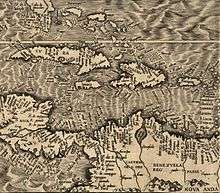
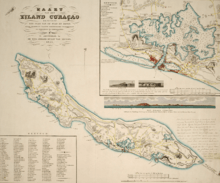
The original inhabitants of Curaçao were the Arawak and Caquetio Amerindians.[19] Their ancestors had migrated to the island from the mainland of South America, likely hundreds of years before Europeans arrived. They were believed to have migrated from the Amazon Basin.
Arrival of Europeans
The first Europeans recorded as seeing the island were members of a Spanish expedition under the leadership of Alonso de Ojeda in 1499.[19] The Spaniards enslaved most of the Arawak for forced labour but paid little attention to the island itself.[19]
In 1634, after the Netherlands achieved independence from Spain following the Eighty Years' War, the fleet of Dutch West India Company under Admiral Johann van Walbeeck invaded the island and the Spaniards on the island surrendered in San Juan in August. The approximately thirty Spaniards and a large part of the indigenous were deported to Santa Ana de Coro in Venezuela. About thirty Taíno families were allowed to live on the island. Dutch colonists started to occupy the island.[19] The WIC founded the capital of Willemstad on the banks of an inlet called the Schottegat; this natural harbour proved to be an ideal place for trade. Commerce and shipping—and piracy—became Curaçao's most important economic activities. Later, salt mining became a major industry, the mineral being a lucrative export at the time. From 1662 the Dutch West India Company made Curaçao a centre for the Atlantic slave trade, often bringing slaves from West Africa here for sale elsewhere in the Caribbean and on the mainland of South America.[19]
Sephardic Jews with ancestors from the Iberian Peninsula settled here with the Dutch and in then-Dutch Brazil; they have had a significant influence on the culture and economy of the island.[20]
In the Franco-Dutch War of 1672–78, Count Jean II d'Estrées planned to attack Curaçao. His fleet – 12 men of war, three fireships, two transports, a hospital ship, and 12 privateers – met with disaster, losing seven men-of-war and two other ships when they struck reefs off the Las Aves archipelago. They had made a serious navigational error, hitting the reefs on 11 May 1678, a week after setting sail from Saint Kitts. Curaçao marked the events by a day of thanksgiving, celebrated for decades into the 18th century, to commemorate the island's escape.
Dutch colonial rule
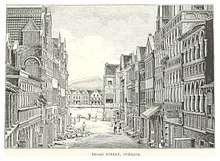
Many Dutch colonists grew affluent from the slave trade, building impressive colonial buildings in the capital of Willemstad; the city is now designated as a UNESCO World Heritage Site. Landhouses (former plantation estates) and West African style kas di pal'i maishi (former slave dwellings) are scattered all over the island.
In 1795, a major slave revolt took place under the leaders Tula Rigaud, Louis Mercier, Bastian Karpata, and Pedro Wakao. Up to 4,000 slaves on the northwest section of the island revolted, with more than 1,000 slaves taking part in extended gunfights. After a month, the slave owners suppressed the revolt.[21][22]
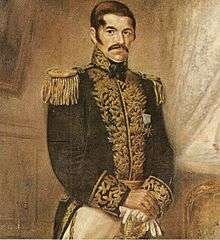
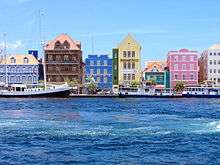
Curaçao's proximity to South America resulted in interaction with cultures of the coastal areas more than a century after independence of Netherlands from Spain. Architectural similarities can be seen between the 19th-century parts of Willemstad and the nearby Venezuelan city of Coro in Falcón State. The latter has also been designated a UNESCO World Heritage Site. Netherlands established economic ties with Viceroyalty of New Granada, which included the present-day countries of Colombia and Venezuela. In the 19th century, Curaçaoans such as Manuel Piar and Luis Brión were prominently engaged in the wars of independence of Venezuela and Colombia. Political refugees from the mainland (such as Simon Bolivar) regrouped in Curaçao.[23] Children from affluent Venezuelan families were educated on the island.
During the 18th and 19th centuries, the British attacked the island several times, most notably in 1800, 1804, and the period from 1807 to 1815.[24]
Stable Dutch rule returned in 1815 at the end of the Napoleonic wars, when the island was incorporated into the colony of Curaçao and Dependencies.[25]
In the early 19th century, Portuguese and Lebanese migrated to Curaçao, attracted by the business opportunities.
The Dutch abolished slavery in 1863, bringing a change in the economy with the shift to wage labor.[25] Some inhabitants of Curaçao emigrated to other islands, such as Cuba, to work in sugarcane plantations. Other former slaves had nowhere to go and remained working for the plantation owner in the tenant farmer system.[26] This was an instituted order in which the former slave leased land from his former master; in exchange, the tenant promised to give up for rent most of his harvest to the former slave master. This system lasted until the beginning of the 20th century.
Historically, Dutch was not widely spoken on the island outside of colonial administration; its use increased in the late 19th and early 20th centuries.[27] Students on Curaçao, Aruba, and Bonaire were taught predominantly in Spanish until the late 17th century, when the British took Curaçao, Aruba, and Bonaire. Teaching of Spanish was restored when Dutch rule resumed in 1815. Also, efforts were made to introduce bilingual popular education in Dutch and Papiamentu in the late 19th century.[28]
20th and 21st centuries
When oil was discovered in the Venezuelan Maracaibo Basin town of Mene Grande in 1914, the economic fortunes of the island were dramatically altered. In the early years, both Shell and Exxon held drilling concessions in Venezuela, which ensured a constant supply of crude oil to the refineries in Aruba and Curaçao. Crude oil production in Venezuela was inexpensive. The integrated companies Shell and Exxon controlled the entire industry from pumping, transporting, and refining to marketing the end product. The refineries on Aruba and Curaçao operated in global markets and were profitable partly because of the margin between the production costs of crude oil and the revenues realized on products. This provided a safety net for losses incurred through inefficiency or excessive operating costs at the refineries.[19]
In 1929 Curaçao was attacked by Venezuelan rebel commander Rafael Simón Urbina, who kidnapped the governor Leonardus Albertus Fruytier. As a result of this incident the Dutch increased their military presence on the island.[29][30]
In 1954 Curaçao was joined with the other Dutch colonies in the Caribbean into the Netherlands Antilles. Discontent with Curaçao's seemingly subordinate relationship to the Netherlands, coupled with ongoing racial discrimination and a rise in unemployment owing to layoffs in the oil industry, led to an outbreak of rioting in 1969.[31] The riots resulted in two deaths, many injuries and severe damage to Willemstad. As a result, the Dutch government introduced far-reaching reforms, allowing Afro-Curaçaoans greater influence in the islands's political and economic life, and raising the prestige of the local language Papiamento.[32]
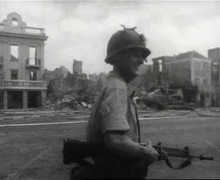
Curaçao experienced an economic downturn in the early 1980s. Shell's refinery on Curaçao operated with significant losses from 1975 to 1979, and again from 1982 to 1985. Persistent losses, global overproduction, stronger competition, and low market expectations threatened the future of the Shell refinery in Curaçao. In 1985, after a presence of 70 years, Royal Dutch Shell decided to end its activities on Curaçao. Shell's announcement came at a crucial moment. The fragile economy of Curaçao had been stagnating for some time. Several revenue-generating endeavours suffered even more during this period: tourism from Venezuela collapsed after the devaluation of the bolivar, the transport industry deteriorated with deleterious effects on the profits of the Antillean Airline Company, and the Curaçao Dry Dock Company experienced major setbacks. The offshore industry (financial services) also experienced a downturn because of new tax laws in the United States.
In the mid-1980s, Shell sold the refinery for the symbolic amount of one Antillean guilder to a local government consortium. The aging refinery has been the subject of lawsuits in recent years, which charge that its emissions, including sulfur dioxide and particulate matter, far exceed safety standards.[33] The government consortium leases the refinery to the Venezuelan state oil company PDVSA.
Continuing economic hardship in the late 1990s and early 2000s has resulted in emigration to the Netherlands being at high levels.[34]
On 1 July 2007, the island of Curaçao was due to become a country within the Kingdom of the Netherlands. On 28 November 2006, this was delayed when the island council rejected a clarification memorandum on the process. A new island council ratified this agreement on 9 July 2007.[35] On 15 December 2008, Curaçao was scheduled to become a separate country within the Kingdom of the Netherlands (as Aruba and the Netherlands Antilles were). A non-binding referendum on this plan took place in Curaçao on 15 May 2009, in which 52% of the voters supported these plans.[36]
Since the dissolution of the Netherlands Antilles
The dissolution of the Netherlands Antilles came into effect on 10 October 2010.[37][38] Curaçao became a country within the Kingdom of the Netherlands, with the Kingdom retaining responsibility for defence and foreign policy. The kingdom is also to oversee the island's finances under a debt-relief arrangement agreed between the two.[39] Curaçao's first prime minister was Gerrit Schotte. He was succeeded in 2012 by Stanley Betrian, ad interim. After elections in 2012 Daniel Hodge became the third prime minister, on 31 December 2012.[40] He led a demissionary cabinet until 7 June 2013, when a new cabinet under the leadership of Ivar Asjes was sworn in.[41]
Although Curaçao is autonomous, the Netherlands has interfered when necessary to ensure that parliamentary elections were held and to assist in finalizing an accurate budget. In July 2017, Prime Minister Eugene Rhuggenaath stated that he wants the island to take full responsibility, but asked for more cooperation and assistance from the Netherlands with suggestions for more innovative approaches to help Curaçao succeed, increasing the standard of living.[42][43] The Dutch government reminded Curaçao that it has provided assistance with oil refinery negotiations with the Chinese "on numerous occasions".[44]
The 2020 COVID-19 pandemic resulted in austerity measures. Curaçao had to impose spending cuts in order to qualify for additional aid from the Netherlands.[45] As part of the austerity package, the Government of Curaçao announced a 12.5% cut on benefits for civil servants.[46] On 24 June 2020, a group of civil servants together with waste collectors from Selikor, marched to Fort Amsterdam, and demanded to speak with Prime Minister Eugene Rhuggenaath[46] The demonstration turned into a riot during which the police cleared the square in front of Fort Amsterdam[47] using tear gas.[48] The city centre of Willemstad was later plundered.[47] 48 people have been arrested,[49] the city districts of Punda and Otrobanda were placed under lock-down for the night, and a general curfew had been announced from 20:30 until 06:00.[50]
Geography
.jpg)


Curaçao, as well as the rest of the ABC islands and also Trinidad and Tobago, lies on the continental shelf of South America. It is a thin island with a generally hilly topography; the highest point is the Mount Christoffelberg 372 m (1,220 ft) in the north-west.[51] The coastlines bays, inlets and hot springs offer an on-site source of natural mineral, thermal, or seawater used in hydrotherapy and mesotherapy, making this island one of many balneoclimateric areas in the region. Off the south-east coast lies the small, flat island of Klein Curaçao.[13]
Flora
The flora of Curaçao differs from the typical tropical island vegetation. Guajira-Barranquilla xeric scrub is the most notably flora with various forms of cacti, thorny shrubs, evergreen, and the watapana tree, Latin name:Libidibia coriaria; called divi-divi on Aruba, characteristic for the ABC islands and the national symbol of Aruba. Brassavola nodosa is a drought tolerant species of Brassavola ; one of the few species of Orchis present in the ABC islands. Cacti include Melocactus and Opuntia species like Opuntia stricta.
Fauna
Curaçao is semiarid, and as such has not supported the numerous tropical species of mammals, birds, and lizards most often associated with rainforests. But birders will not be disappointed by the dozens of species of hummingbirds, bananaquits, orioles, and the larger terns, herons, egrets, and even flamingos that make their homes near ponds or in coastal areas. The trupial, a black bird with a bright orange underbelly and white swatches on its wings, is common to the island and to Curaçao. The Mockingbird, called Chuchubi in Papiamentu, resembles the North American mockingbird, with a long white-gray tail and a gray back. Near the shore, note the big-billed brown pelicans that dive, straight down like dead weight, into the ocean after fish. Other seabirds include several types of gulls and large cormorants.
Of mammals, other than some field mice, small rabbits, and cave bats, Curaçao's most notable animal is the white-tailed deer. This deer is related to the American white-tailed deer, or Virginia deer, found in spots from North America through Central America and the Caribbean, and as far south as Bolivia. It can be a large deer, some reaching six feet (2 m) in length and three feet (0.9 m) in height, and weighing as much as 300 pounds (140 kg). It has a long tail with a white underside, and is the only type of deer on the island. It is a protected species (since 1926), and an estimated 200 live on Curaçao. They're found in many parts of the island, but most notably at the west end's Christoffel Park, where about 70% of the herd resides. Archaeologists believe that the deer was brought from South America to Curaçao by its original inhabitants, the Arawaks.
There are several species of iguana, light green in color with shimmering shades of aqua along the belly and sides, lounging in the sun here and there. The iguanas found on Curaçao are not only nice to look at, but, unlike many islands that gave up the practice years ago, remain fodder for the dinner table. Along the west end of the island's north shore are several inlets that have become home to breeding sea turtles. These turtles are protected by the park system in Shete Boka Park, and can be visited accompanied by park rangers.
Climate
Curaçao has a semi-arid climate (Köppen climate classification BSh) with a dry season from January to September and a wet season from October to December.[52] The temperatures are relatively constant with small differences throughout the year. The trade winds bring cooling during the day and the same trade winds bring warming during the night. The coolest month is January with an average temperature of 26.6 °C (80 °F) and the warmest month is September with an average temperature of 29.1 °C (84 °F). The year's average maximum temperature is 31.4 °C (89 °F). The year's average minimum temperature is 25.7 °C (78 °F). The seawater around Curaçao averages around 27°C and are coldest (Av. 25.9°C ) around February-March and warmest (Av. 28.2°C) around September-October.
Curaçao lies outside the hurricane belt, but is still occasionally affected by hurricanes, as for example Hazel in 1954, Anna in 1961, Felix in 2007, and Omar in 2008. A landfall of a hurricane in Curaçao has not occurred since the United States National Hurricane Center started tracking hurricanes. Curaçao has, however, been directly affected by pre-hurricane tropical storms several times; the latest which to do so were Tomas in 2010, Cesar in 1996, Joan-Miriam in 1988, Cora and Greta in 1978, Edith and Irene in 1971, and Francelia in 1969. Tomas brushed Curaçao as a tropical storm, dropping as much as 265 mm (10.4 in) of precipitation on the territory, nearly half of the annual precipitation in one day.[53] This made Tomas one of the wettest events in the island's history,[54] as well as one of the most devastating; its flooding killed two people and caused over NAƒ60 million (US$28 million) in damage.[55][56] However, according to the Emissions Database for Global Atmospheric Research, average carbon dioxide emissions per person were 52 tonnes in 2018, the second highest in the world.[57]
Meteo, the Curaçao Weather Department, provides up to date information about weather conditions, via its website and mobile apps for iOS and Android.
| Climate data for Curaçao - Hato International airport (TNCC) (1981-2010) | |||||||||||||
|---|---|---|---|---|---|---|---|---|---|---|---|---|---|
| Month | Jan | Feb | Mar | Apr | May | Jun | Jul | Aug | Sep | Oct | Nov | Dec | Year |
| Record high °C (°F) | 33.3 (91.9) |
33.2 (91.8) |
33.0 (91.4) |
34.7 (94.5) |
36.0 (96.8) |
37.5 (99.5) |
35.0 (95.0) |
37.4 (99.3) |
38.3 (100.9) |
36.0 (96.8) |
35.6 (96.1) |
33.3 (91.9) |
38.3 (100.9) |
| Average high °C (°F) | 29.9 (85.8) |
30.1 (86.2) |
30.7 (87.3) |
31.4 (88.5) |
32.0 (89.6) |
32.1 (89.8) |
32.1 (89.8) |
32.7 (90.9) |
32.8 (91.0) |
32.1 (89.8) |
31.1 (88.0) |
30.3 (86.5) |
31.4 (88.5) |
| Daily mean °C (°F) | 26.6 (79.9) |
26.7 (80.1) |
27.2 (81.0) |
27.8 (82.0) |
28.4 (83.1) |
28.6 (83.5) |
28.5 (83.3) |
28.9 (84.0) |
29.1 (84.4) |
28.6 (83.5) |
28.0 (82.4) |
27.2 (81.0) |
28.0 (82.4) |
| Average low °C (°F) | 24.4 (75.9) |
24.5 (76.1) |
24.9 (76.8) |
25.6 (78.1) |
26.3 (79.3) |
26.5 (79.7) |
26.1 (79.0) |
26.5 (79.7) |
26.6 (79.9) |
26.2 (79.2) |
25.6 (78.1) |
24.9 (76.8) |
25.7 (78.3) |
| Record low °C (°F) | 21.5 (70.7) |
20.6 (69.1) |
21.3 (70.3) |
22.0 (71.6) |
21.6 (70.9) |
22.4 (72.3) |
22.3 (72.1) |
21.3 (70.3) |
22.7 (72.9) |
21.9 (71.4) |
22.0 (71.6) |
21.6 (70.9) |
20.6 (69.1) |
| Average rainfall mm (inches) | 46.0 (1.81) |
28.8 (1.13) |
14.1 (0.56) |
19.4 (0.76) |
21.3 (0.84) |
22.4 (0.88) |
41.3 (1.63) |
39.7 (1.56) |
49.1 (1.93) |
102.0 (4.02) |
122.4 (4.82) |
95.5 (3.76) |
602 (23.7) |
| Average rainy days (≥ 1.0 mm) | 8.5 | 5.5 | 2.5 | 2.4 | 2.2 | 3.3 | 6.4 | 4.6 | 4.7 | 8.1 | 10.9 | 11.4 | 70.5 |
| Average relative humidity (%) | 78.5 | 78.2 | 77.3 | 78.2 | 77.9 | 77.5 | 78.1 | 77.8 | 78.1 | 79.6 | 80.6 | 79.5 | 78.4 |
| Mean monthly sunshine hours | 264.7 | 249.6 | 271.8 | 249.4 | 266.3 | 266.7 | 290.4 | 302.5 | 261.7 | 247.8 | 234.7 | 247.1 | 3,152.7 |
| Source: METEOROLOGICAL DEPARTMENT CURACAO,[58] | |||||||||||||
Geology
The northern sea floor drops steeply within 60 m (200 ft) of the shore. This drop-off is known as the "blue edge".
On Curaçao, four major geological formations can be found: the lava formation, the Knip formation, the Mid-Curaçao formation and limestone formations.[59]
Curaçao lies within the Caribbean large igneous province (CLIP) with key exposures of those lavas existing on the island consisting of the Curaçao Lava Formation (CLF). The CLF consists of 5 km of pillow lavas with some basalt intrusions. The ages of these rocks include 89 Ma for the lavas and 75 Ma for the poikilitic sills, though some sequences may have erupted as late as 62–66 Ma, placing them in the Cretaceous. Their composition includes picrite pillows at the base, followed by tholeiitic lavas, then hyaloclastites, then the poikilitic sills. The CLF was gradually uplifted until Eocene-Miocene limestone caps formed, before final exposure above sea level. Christoffelberg and the Zevenbergen (Seven Hills) portion of the island have exposures of the Knip Formation. This formation includes deepwater deposits of calcareous sands and fine clays, capped by siliceous chert containing radiolarians. Middle Curaçao contains alluvial soils from eroded CLF and limestone.[60][61]
Forts
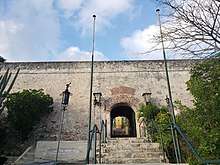
When the Dutch arrived in 1634, they built forts at key points around the island to protect themselves from foreign powers, privateers, and pirates. Six of the best-preserved forts can still be seen today:
- Fort Amsterdam (1635)
- Fort Beekenburg (1703)
- Fort Nassau (1797)
- Waterfort (1826)
- Riffort (1828)[62]
- Piscadera Bay Fort (built between 1701 and 1704)
In 1957, the Hotel Van der Valk Plaza Curaçao was built on top of the Waterfort.[63]
The Riffort contains restaurants and shops. It is located on the opposite side of the Waterfort across the entrance to the harbour in Otrobanda. In 2009, the Renaissance Curaçao Resort and Casino opened next to the Riffort.[64][65]
Government

Curaçao is a constituent country of the Kingdom of the Netherlands.[13] Its governance takes place in a framework of a parliamentary representative democracy. The King of the Netherlands is the head of state, represented locally by a Governor, with the Prime Minister of Curaçao being the head of government.[13] Executive power is exercised by the government. Legislative power is vested in both the government and parliament.
The judiciary is independent of the executive and the legislature. Convicted felons are held at the Curaçao Centre for Detention and Correction prison.
Curaçao has full autonomy on most matters, with the exceptions summed up in the Charter for the Kingdom of the Netherlands under the title "Kingdom affairs".
Military
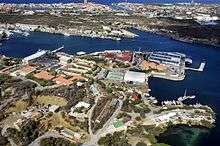
Defence of the island is the responsibility of the Netherlands.[13]
Two Dutch naval bases, Parera and Suffisant, are located on the island of Curaçao. Officers of the Arubaanse Militie complete further training on Curaçao.
On the west side of Curaçao International Airport are hangars for the two Bombardier Dash 8 Maritime Patrol Aircraft and two AgustaWestland AW139 helicopters of the Dutch Caribbean Coast Guard. This was until 2007 a naval airbase of the Royal Netherlands Navy, which operated the base for 55 years, with a wide variety of aircraft in the past years Fireflies, Avengers, Trackers, Neptunes, Fokker F-27s, P-3C Orions, Fokker F-60s and several helicopters. After the political decision to sell all Orions the airbase wasn't needed anymore.
The west end of the airport is a USAF Forward Operating Location (FOL). The base hosts Airborne Warning And Control System (AWACS) and transport aircraft. Until 1999 the USAF operated a small fleet of F-16 fighters from the FOL.
Conscription
Suffisant Naval Base has facilities used for conscription in the Caribbean. There has not been military conscription since 1997, but a form of civil conscription has been in place. This type of conscription offers underprivileged Antillean young people the chance of undertaking professional training.[66]
Politics
The politics of Curaçao reflect the tensions created by socio-economic inequalities as well as the racial hierarchies that are the legacies of colonialism and the Atlantic Slave trade . Decolonization and the ongoing political relationship between Curaçao and the Netherlands have also been sites of tension. In 2010 Curaçao became an autonomous country as part of the Kingdom of the Netherlands. The island country in the Caribbean off the coast of Venezuela was part of the Netherlands Antilles. Sint Maarten island also became autonomous, while the less-populated islands of Bonaire, Sint Eustatius and Saba are municipalities governed by the Netherlands.[67]
Economy
.jpg)
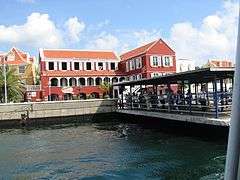
Curaçao has an open economy, with tourism, international trade, shipping services, oil refining,[68] storage (oil and bunkering) and international financial services being the most important sectors.[13] The Venezuelan state oil company PDVSA has a lease on the island's oil refinery expiring in 2019; the facility employs 1,000 people, refining oil from Venezuela for export to the US and Asia.[69] Schlumberger, the world's largest oil field services company is incorporated in Curaçao.[70] The Isla oil refinery is claimed to be responsible for Curaçao's position in the world's top five highest countries for CO2 emissions per capita.[71]
Along with Sint Maarten, Curaçao uses the Netherlands Antillean guilder as its currency.[13] Its economy is well developed, supporting a high standard of living, ranking 46th in the world in terms of GDP (PPP) per capita and 27th in the world in terms of nominal GDP per capita. Curaçao possesses a high income economy, as defined by the World Bank.[72][73] Activities related to the port of Willemstad (like the Free Trade Zone) make a significant contribution to the economy.[13] To achieve the government's aim to make its economy more diverse, efforts are being made to attract more foreign investment.[13] This policy, called the "Open Arms" policy, features a heavy focus on information technology companies.[74][75][76]
Reduced foreign demand due to ongoing unrest and political uncertainty in Venezuela has led to decreased exports along with increased public demands for services and goods which has resulted in economic stagnation since 2016. Expansion was recorded in the construction, financial intermediation, and utilities sectors while other aspects of the economy contracted.[77]
Tourism
.jpg)
While tourism plays a major role in Curaçao's economy, it is less reliant on tourism than other Caribbean countries. Most tourists originate from the Netherlands, the eastern United States, South America and other Caribbean Islands. It is a leader in the Caribbean in cruise tourism growth with 610,186 cruise passengers in 2013, a 41.4% increase over the prior year.[78] Hato International Airport received 1,772,501 passengers in 2013 and recently announced capital investments totaling US$48 million aimed at transforming the airport into a regional hub by 2018.
The island's insular shelf has a sharp drop-off known as the "Blue Edge" which is often visited by scuba diving tourists.[79] Coral reefs for snorkeling and scuba diving can be reached without a boat. The southern coast has calm waters as well as many small beaches, such as Jan Thiel and Cas Abou. The coastline of Curaçao features numerous bays and inlets which serve as popular mooring locations for boats.[80]
In June 2017, the island was named the Top Cruise Destination in the Southern Caribbean by Cruise Critic, a major online forum. The winners of the Destination Awards were selected based on comments from cruise passengers who rated the downtown area of Willemstad as "amazing" and the food and shopping as "excellent".[81]
Some of the coral reefs are affected by tourism. Porto Marie Beach is experimenting with artificial coral reefs in order to improve the reef's condition. Hundreds of artificial coral blocks that have been placed are now home to a large array of tropical fish. It is now under investigation to see if the sewer waste of hotels is a partial cause of the dying of the coral reef.[82]
Labour
In 2016, a Labor Force Survey (LFS) indicated that the unemployment rate was 13.3%. For residents aged 15–64, the employment rate was 70.4%.[83][84]
Financial services
Curaçao's history in financial services dates back to World War I. Prior to this period, the financial arms of local merchant houses functioned as informal lenders to the community. However, at the turn of the 20th century, Curaçao underwent industrialization, and a number of merchant houses established private commercial banks.[85] As the economy grew, these banks began assuming additional functions eventually becoming full-fledged financial institutions.
The Dutch Caribbean Securities Exchange is located in the capital of Willemstad, as is the Central Bank of Curaçao and Sint Maarten; the latter of which dates to 1828. It is the oldest central bank in the Western Hemisphere.[86] The island's legal system supports a variety of corporate structures and is a corporate haven. Though Curaçao is considered a tax haven, it adheres to the EU Code of Conduct against harmful tax practices. It holds a qualified intermediary status from the United States Internal Revenue Service. It is an accepted jurisdiction of the OECD and Caribbean Financial Action Task Force on Money Laundering. The country enforces Anti-Money Laundering and Counter-Terrorism funding compliance.
Foreign Account Tax Compliance Act
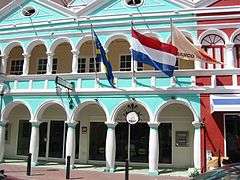
On 30 June 2014, Curaçao[87] was deemed to have an Inter-Governmental Agreement (IGA) with the United States of America with respect to the "Foreign Account Tax Compliance Act" of the United States of America. The Tax Information Exchange Agreement signed in Washington, D.C. on 17 April 2002[88] between the U.S. and the Kingdom of the Netherlands includes Curaçao, and was updated with respect to Curaco in 2014, taking effect in 2016.
Trade
Curaçao trades mainly with the United States, Venezuela, and the European Union. It has an Association Agreement with the European Union which allows companies which do business in and via Curaçao to export products to European markets,[89] free of import duties and quotas. It is also a participant in the US Caribbean Basin Initiative allowing it to have preferential access to the US market.[90]
Prostitution
Prostitution in Curaçao is legal only for foreign women who get a temporary permit to work in the large open-air brothel called "Le Mirage" or "Campo Alegre". Using prostitution services is legal for men (locals included). The brothel has operated near the airport since the 1940s.[91][92] Curaçao monitors, contains and regulates the industry. The government states that the workers in these establishments are thereby given a safe environment and access to medical practitioners. However this approach does exclude local women (or men) to legally make a living from prostitution and does lead to loss of local income, as the foreign prostitutes send or take most of their earnings home.[93]
The U.S. State Department has cited anecdotal evidence claiming that, "Curaçao...[is a] destination island... for women trafficked for the sex trade from Peru, Brazil, Colombia, the Dominican Republic, and Haiti, according to local observers. At least 500 foreign women reportedly are in prostitution throughout the five islands of the Antilles, some of whom have been trafficked."[94] The US Department of State has said that the government of Curaçao frequently underestimates the extent of human trafficking problems.[94]
Demographics
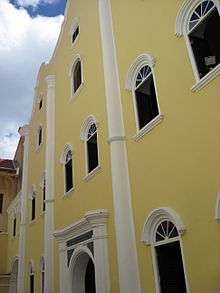
Owing to the island's history of slavery, the majority of the Curaçaoans are of African or partially African ethnicity.[13] There are also many people of Dutch, French, Latin American, South Asian, East Asian, and Levantine descent.
Religion
- Religion in Curaçao[95]
The religious breakdown of the population of Curaçao, according to a 2011 estimate:[95]
- Roman Catholic;[95] 69.8%
- Pentecostal;[95] 7.6%
- Other Protestant;[95] 3.2%
- Adventist;[95] 9%
- Jehovah's Witnesses;[95] 2%
- Evangelical;[95] 8.9%
- Other;[95] 3.8%
- None;[95] 10%
- Unspecified;[95] 0.6%
This includes a shift towards the charismatic renewal or charismatic movement since the mid-1970s. Other denominations include the Seventh-day Adventist Church and the Methodist Church. Alongside these Christian denominations, some inhabitants practice Montamentu and other diaspora African religions.[96] As elsewhere in Latin America, Pentecostalism is on the rise. There are also practising Muslims and Hindus.
The Roman Catholic Diocese of Willemstad encompasses all the territory of the Kingdom of the Netherlands in the Caribbean which includes Aruba, Curaçao, Sint Maarten, and the islands of Bonaire, St. Eustatius and Saba. The diocese is also a member of the Antilles Episcopal Conference.
While small, Curaçao's Jewish community has had a significant impact on the island's history.[20] Curaçao has the oldest active Jewish congregation in the Americas, dating to 1651. The Curaçao synagogue is the oldest synagogue of the Americas in continuous use, since its completion in 1732 on the site of a previous synagogue.[97] Additionally, there are both Sephardic and Ashkenazi Jewish communities.[13] As of the year 2000 there were approximately 300 Jewish people living on the island.[98]
Languages
Curaçao is a polyglot society. The official languages are Dutch, Papiamentu and English.[1][13] However, Dutch is the sole language for all administration and legal matters.[99] Most of Curaçao's population is able to converse in at least two of the languages of Papiamentu, Dutch, English, and Spanish.
The most widely spoken language is Papiamentu, a Portuguese creole with African, Dutch and Spanish influences, spoken in all levels of society.[13] Papiamentu was introduced as a language of primary school education in 1993, making Curaçao one of a handful of places where a creole language is used as a medium to acquire basic literacy.[100] Spanish and English also have a long historical presence in Curaçao. Spanish became an important language in the 18th century due to the close economic ties with Spanish territories in what are now Venezuela and Colombia[27] and several Venezuelan TV networks are received. Use of English dates to the early 19th century, when the British took Curaçao, Aruba and Bonaire. When Dutch rule resumed in 1815, officials already noted wide use of the language.[27]
According to the 2001 census, Papiamentu is the first language of 81.2% of the population. Dutch is the first language of 8%, Spanish of 4%, and English of 2.9%.[101] However, these numbers divide the population in terms of first language and do not account for the high rate of bilingualism in the population of Curaçao.
Statistics
Births and deaths[102]
| Year | Population | Live births | Deaths | Natural increase | Crude birth rate | Crude death rate | Rate of natural increase | TFR |
|---|---|---|---|---|---|---|---|---|
| 2009 | 1,898 | 1,114 | 784 | 12.9 | 7.6 | 5.3 | 2.038 | |
| 2010 | 2,032 | 1,246 | 786 | 13.7 | 8.4 | 5.3 | 2.199 | |
| 2011 | 1,974 | 1,276 | 698 | 13.1 | 8.5 | 4.6 | 2.076 | |
| 2012 | 2,039 | 1,240 | 793 | 13.4 | 8.2 | 5.2 | 2.168 | |
| 2013 | 152,760 | 1,959 | 1,200 | 709 | 12.7 | 8.1 | 4.6 | 2.052 |
| 2014 | 1,963 | 1,370 | 593 | 12.6 | 8.8 | 3.8 | 2.009 | |
| 2015 | 1,874 | 1,398 | 476 | 11.9 | 8.8 | 3.1 | 1.863 | |
| 2016 | 1,789 | 1,482 | 307 | 11.2 | 9.3 | 1.9 |
Structure of the population[103]
As of 1 July 2013:
| Age Group | Male | Female | Total | % |
|---|---|---|---|---|
| Total | 70,342 | 83,479 | 153,821 | 100 |
| 0–4 | 4,919 | 4,615 | 9,534 | 6.20 |
| 5–9 | 4,824 | 4,648 | 9,472 | 6.16 |
| 10–14 | 5,362 | 5,028 | 10,390 | 6.75 |
| 15–19 | 5,510 | 5,377 | 10,886 | 7.08 |
| 20–24 | 4,165 | 4,371 | 8,536 | 5.55 |
| 25–29 | 3,672 | 4,403 | 8,075 | 5.25 |
| 30–34 | 3,527 | 4,803 | 8,330 | 5.42 |
| 35–39 | 3,939 | 5,165 | 9,103 | 5.92 |
| 40–44 | 5,031 | 6,337 | 11,367 | 7.39 |
| 45–49 | 5,352 | 6,811 | 12,163 | 7.91 |
| 50–54 | 5,506 | 7,197 | 12,703 | 8.26 |
| 55–59 | 4,801 | 6,130 | 10,931 | 7.11 |
| 60–64 | 4,271 | 5,327 | 9,597 | 6.24 |
| 65–69 | 3,507 | 4,477 | 7,983 | 5.19 |
| 70–74 | 2,419 | 3,236 | 5,655 | 3.68 |
| 75–79 | 1,794 | 2,473 | 4,267 | 2.77 |
| 80–84 | 1,056 | 1,601 | 2,657 | 1.73 |
| 85–89 | 476 | 897 | 1,373 | 0.89 |
| 90–94 | 166 | 430 | 596 | 0.39 |
| 95–99 | 42 | 129 | 171 | 0.11 |
| 100+ | 8 | 30 | 38 | 0.02 |
| Age group | Male | Female | Total | Percent |
|---|---|---|---|---|
| 0–14 | 15,105 | 14,291 | 29,396 | 19.11 |
| 15–64 | 45,769 | 55,915 | 101,684 | 66.11 |
| 65+ | 9,468 | 13,273 | 22,741 | 14.78 |
Education
Public education is based on the Dutch educational system and besides the public schools, private and parochial schools are also available. Since the introduction of a new public education law in 1992, compulsory primary education starts at age six and continues for six years; secondary lasts for another four.[104]
The main institute of higher learning is the University of Curaçao (formerly University of The Netherlands Antilles), enrolling 2,100 students.[104] The comprehensive model of education is influenced by both the Dutch and American education systems. Other higher education offerings on the island include offshore medical schools, language schools and academies for fine art, music, police, teacher and nurse-training.[105]
Culture
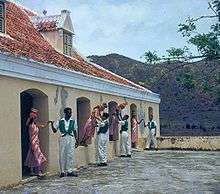
Literature
Despite the island's relatively small population, the diversity of languages and cultural influences on Curaçao have generated a remarkable literary tradition, primarily in Dutch and Papiamentu. The oral traditions of the Arawak indigenous peoples are lost. West African slaves brought the tales of Anansi, thus forming the basis of Papiamentu literature. The first published work in Papiamentu was a poem by Joseph Sickman Corsen entitled Atardi, published in the La Cruz newspaper in 1905. Throughout Curaçaoan literature, narrative techniques and metaphors best characterized as magic realism tend to predominate. Novelists and poets from Curaçao have contributed to Caribbean and Dutch literature. Best known are Cola Debrot, Frank Martinus Arion, Pierre Lauffer, Elis Juliana, Guillermo Rosario, Boeli van Leeuwen and Tip Marugg.
Cuisine
Local food is called Krioyo (pronounced the same as criollo, the Spanish word for "Creole") and boasts a blend of flavours and techniques best compared to Caribbean cuisine and Latin American cuisine. Dishes common in Curaçao are found in Aruba and Bonaire as well. Popular dishes include: stobá (a stew made with various ingredients such as papaya, beef or goat), Guiambo (soup made from okra and seafood), kadushi (cactus soup), sopi mondongo (intestine soup), funchi (cornmeal paste similar to fufu, ugali and polenta) and a lot of fish and other seafood. The ubiquitous side dish is fried plantain. Local bread rolls are made according to a Portuguese recipe. All around the island, there are snèks which serve local dishes as well as alcoholic drinks in a manner akin to the English public house.
The ubiquitous breakfast dish is pastechi: fried pastry with fillings of cheese, tuna, ham, or ground meat. Around the holiday season special dishes are consumed, such as the hallaca and pekelé, made out of salt cod. At weddings and other special occasions a variety of kos dushi are served: kokada (coconut sweets), ko'i lechi (condensed milk and sugar sweet) and tentalaria (peanut sweets). The Curaçao liqueur was developed here, when a local experimented with the rinds of the local citrus fruit known as laraha. Surinamese, Chinese, Indonesian, Indian and Dutch culinary influences also abound. The island also has a number of Chinese restaurants that serve mainly Indonesian dishes such as satay, nasi goreng and lumpia (which are all Indonesian names for the dishes). Dutch specialties such as croquettes and oliebollen are widely served in homes and restaurants.
Sports
The Curaçao national football team travelled to Thailand and participated in the 2019 King's Cup for the first time, eventually winning the tournament by beating Vietnam in the final.[106]
In 2004, the Little League Baseball team from Willemstad, Curaçao, won the world title in a game against the United States champion from Thousand Oaks, California. The Willemstad lineup included Jurickson Profar, the standout shortstop prospect who now plays for the San Diego Padres of Major League Baseball, and Jonathan Schoop.
The 2010 documentary film, Boys of Summer,[107] details Curaçao's Pabao Little League All-Stars winning their country's eighth straight championship at the 2008 Little League World Series, then going on to defeat other teams, including Puerto Rico and the Dominican Republic, and earning a spot in Williamsport.
The prevailing trade winds and warm water make Curaçao a location for windsurfing.[108][109]
There is warm, clear water around the island. Scuba divers and snorkelers may have visibility up to 30 metres (98 feet) at the Curaçao Underwater Marine Park, which stretches along 20 kilometres (12 miles) of Curaçao's southern coastline.[110]
Curaçao participated in the 2013 CARIFTA Games. Kevin Philbert stood third in the under-20 male Long Jump with a distance of 7.36 metres (24.15 feet). Vanessa Philbert stood second the under-17 female 1,500 metres (4,900 feet) with a time of 4:47.97.[111][112][113][114]
Infrastructure
Airport
Curaçao International Airport (also called Hato International Airport) is located on the northern coast of the island and offers connections to the Caribbean region, South America, North America and Europe. Curaçao Airport is a fairly large facility, with the third longest commercial runway in the Caribbean region after Rafael Hernández Airport in Puerto Rico and Pointe-à-Pitre International Airport in Guadeloupe. The airport served as a main base for Insel Air, and for Air ALM, the former national airlines of Curaçao.
Bridges
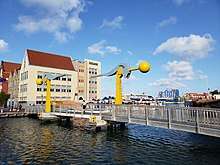
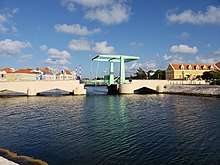
The Queen Emma Bridge, a 168 metres (551 ft) long pontoon bridge, connects pedestrians between the Punda and Otrobanda districts.[115] This swings open to allow the passage of ships to and from the port.[116] The bridge was originally opened in 1888 and the current bridge was installed in 1939.[117] It is best known and, more often than not, referred to by the locals as "Our Swinging Old Lady".[118]
The Queen Juliana Bridge connects mobile traffic between the same two districts. At 185 feet (56 m) above the sea, it is one of the highest bridges in the Caribbean.[116]
Utilities and sanitation
Aqualectra, a government-owned company[119] and full member of CARILEC, delivers potable water and electricity to the island. Rates are controlled by the government. Water is produced by reverse osmosis or desalinization.[120] It services 69,000 households and companies using 130,000 water and electric meters.[120] The power generation company NuCuraçao opened wind farms in Tera Kora and Playa Kanoa in 2012, and expanded in Tera Kora in 2015.[121] There is no natural gas distribution grid; gas is supplied to homes by pressurized containers.[122]
Curbside trash pickup is provided by the company Selikor. There is no recycling pickup, but there are drop-off centers for certain recycled materials at the Malpais landfill,[123] and various locations operated by Green Force;[124][125] private haulers recycle construction waste, paper, and cardboard.[126][127][128]
Notable residents
People from Curaçao include:
Arts and culture
- Tip Marugg, writer
- Izaline Calister, singer-songwriter
- Sherman Smith (musician), singer-songwriter
- Ruënna Mercelina, model, actress, beauty queen[129]
- Peter Hartman, past-CEO of KLM
- Kizzy McHugh, a singer songwriter and television personality based in the United States
- No Game, popular band
- Robby Müller, cinematographer, closely associated with Wim Wenders and Jim Jarmusch[130]
- Pernell Saturnino, a graduated percussionist of Berklee College of Music[131]
- Wim Statius Muller, composer, pianist
Politics and government
- Luis Brión, admiral in the Venezuelan War of Independence
- Moises Frumencio da Costa Gomez, first Prime Minister of the Netherlands Antilles
- George Maduro, a war hero and namesake of Madurodam in The Hague
- Manuel Carlos Piar, general and competitor of Bolivar during the Venezuelan War of Independence
- Tula, leader of the 1795 slave revolt
Sports
Baseball
Players in Minor League Baseball:
- Sharlon Schoop,[132] professional infielder
Players in Major League Baseball:
- Wladimir Balentien, professional outfielder[133]
- Roger Bernadina, professional outfielder[134]
- Didi Gregorius, professional shortstop[135]
- Kenley Jansen, professional pitcher[136]
- Andruw Jones, professional outfielder[137]
- Jair Jurrjens, professional pitcher[138]
- Shairon Martis, professional pitcher[139]
- Jurickson Profar, professional infielder[140]
- Jonathan Schoop, professional infielder[141]
- Andrelton Simmons, professional shortstop[142]
- Hensley Meulens, professional baseball player and hitting coach[143]
- Randall Simon, first baseman[144]
- Ozzie Albies, professional second baseman[145]
Football
- Vurnon Anita, a football player for Leeds United in the English EFL Championship[146]
- Leandro Bacuna, footballer playing for Cardiff City in the English EFL Championship.
- Roly Bonevacia, a footballer who plays for Al-Faisaly in the Saudi Professional League[147]
- Tahith Chong, a footballer playing for Manchester United in the English Premier League.
- Rangelo Janga, a footballer who plays for FC Astana in the Kazakhstan Premier League.
- Jürgen Locadia, footballer playing for Brighton & Hove Albion in the English Premier League.
- Cuco Martina, footballer playing for Everton in the English Premier League
- Bradley Martis, footballer playing for Sparta Rotterdam in the Dutch Eerste Divisie
- Quentin Martinus, footballer playing for Urawa Red Diamonds in the Japan J1 League.
- Darryl Lachman, footballer who plays for PEC Zwolle in the Dutch Eredivisie.
- Juninho Bacuna, footballer playing for Huddersfield Town in the English EFL Championship.
- Eloy Room, footballer playing for Columbus Crew SC in Major League Soccer.
- Jeremy Cijntje, footballer playing for Heracles in the Dutch Eredivisie.
- Jetro Willems, footballer playing for Eintracht Frankfurt in the German Bundesliga.[148]
- Sontje Hansen, footballer playing for Ajax in the Dutch Eredivisie.
Other sports
- Marc de Maar, professional cyclist[149]
- Churandy Martina, gold medalist 100 metres at the Pan American Games 2007[150]
- Jean-Julien Rojer, professional tennis player[151]
- Jemyma Betrian, professional mixed-martial-arts (MMA) fighter[152]
- Liemarvin Bonevacia, professional sprinter
- Roelly Winklaar, IFBB pro bodybuilder
- Jordann Pikeur, professional kickboxer
See also
Notes
-
- "LANDSVERORDENING van de 28ste maart 2007 houdende vaststelling van de officiële talen (Landsverordening officiële talen)" (in Dutch). Government of the Netherlands. 10 October 2010. Retrieved 27 July 2013.
- "Over Curaçao" (in Dutch). Government of Curaçao. Archived from the original on 21 September 2013. Retrieved 19 September 2013.
- "The World Factbook – Central Intelligence Agency". cia.gov. Retrieved 29 December 2019.
- "Waaruit bestaat het Koninkrijk der Nederlanden? - Rijksoverheid.nl". 19 May 2015.
- "Country Report Curaçao". Rabobank. Retrieved 23 August 2017.
- COUNTRY COMPARISON GDP PURCHASING POWER PARITY, Central Intelligence Agency.
- "Human Development Index (HDI): Korte Notitie inzake de berekening van de voorlopige Human Development Index (HDI) voor Curaçao" (PDF). Centraal Bureau voor de Statistiek. Archived from the original (PDF) on 13 July 2015. Retrieved 13 July 2015.
- Wells, John C. (2008), Longman Pronunciation Dictionary (3rd ed.), Longman, ISBN 9781405881180
- Mangold, Max (2005). "Curaçao". In Franziska Münzberg (ed.). Aussprachewörterbuch. Mannheim: Duden Verlag. ISBN 978-3-411-04066-7. Retrieved 16 June 2011.
- "CIA World Factbook – Curaçao". Retrieved 15 July 2019.
- English name used by the Government of Curaçao and the Government of the Netherlands Antilles (English was an official language of the Netherlands Antilles and the Island Territory of Curaçao)
- Formal name according to "Art. 1 para 1 Constitution of Curaçao" (PDF). Archived from the original (PDF) on 22 July 2011. (Dutch version)
- Formal name according to "Art. 1 para 1 Constitution of Curaçao" (PDF). Archived from the original (PDF) on 2 September 2009. (Papiamentu version)
- "CIA World Factbook- Curaçao". Retrieved 15 July 2019.
- Joubert and Van Buurt, 1994
- "Curaçao", Curaçao-nature.com, 2005–2016. Retrieved 12 August 2016
- "Taino Names of the Caribbean Islands". 2 February 2015.
- Cock's 1562 map, Library of Congress website
- "Curaçao". www.globalsecurity.org. Retrieved 22 September 2019.
- "The History of Curaçao". Retrieved 15 July 2019.
- "Curacao Virtual Jewish History Tour". jewishvirtuallibrary.org.
- "Curaçao History". Papiamentu.net. Retrieved 10 October 2010.
- Rodriguez, Junius P. (2007). Encyclopedia of Slave Resistance and Rebellion. Greenwood Publishing Group. ISBN 9780313332739.
- "Octagon Museum – Curaçao Art".
- "Curacao in the British Empire".
- "The History of Curaçao". Retrieved 15 July 2019.
- Called "Paga Tera"
- Dede pikiña ku su bisiña: Papiamentu-Nederlands en de onverwerkt verleden tijd. van Putte, Florimon., 1999. Zutphen: de Walburg Pers
- Van Putte 1999.
- "Overval op fort Amsterdam in Willemstad op Curaçao door de Venezolaanse revolutionair Urbina (8 juni 1929)" (in Dutch). Ministry of Defense. Archived from the original on 28 March 2014. Retrieved 8 August 2014.
- "WHKMLA : List of Wars of the Dutch Republic / Netherlands".
- Anderson & Dynes 1975, p. 81, Oostindie & Klinkers 2013, p. 98, "Striking Oil Workers Burn, Loot in Curacao". Los Angeles Times. May 31, 1969, p. 2.
- Anderson & Dynes 1975, pp. 100–101, Sharpe 2015, p. 122, Verton 1976, p. 90, "Nieuwe ministers legden eed af" (in Dutch). Amigoe di Curaçao. December 12, 1969, p. 1.
- "Curaçao refinery sputters on, despite emissions". Reuters. 30 June 2008. Retrieved 30 June 2008.
- "The Dutch migration monitor: Backgrounds and developments of different types of international migration" (PDF). Wodc.nl. Archived from the original (PDF) on 20 August 2016. Retrieved 23 August 2017.
- The Daily Herald St. Maarten (9 July 2007). "Curaçao IC ratifies 2 November accord". Archived from the original on 11 July 2007. Retrieved 13 July 2007.
- "Curaçao referendum approves increasing autonomy". Newser. 15 May 2009. Archived from the original on 7 June 2019. Retrieved 23 May 2009.
- Koninkrijksrelaties, Ministerie van Binnenlandse Zaken en (13 December 2011). "New constitutional order – Caribbean Parts of the Kingdom – Government.nl". Government.nl. Retrieved 23 August 2017.
- "NOS Nieuws – Antillen opgeheven op 10-10-2010". Nos.nl. 18 November 2009. Archived from the original on 4 October 2009. Retrieved 10 October 2010.
- "Status change means Dutch Antilles no longer exists". BBC News. 10 October 2010.
- "Curaçao heeft een tussenkabinet, dat vooral moet bezuinigen" (in Dutch). 31 December 2012. Retrieved 31 December 2012.
- "Regering Curaçao beëdigd" (in Dutch). 7 June 2013. Retrieved 7 June 2013.
- "Curaçao Prime Minister wants to do business with the Netherlands". Curacaochronicle.com. 4 July 2017. Retrieved 23 August 2017.
- "Premier Rhuggenaath participates High Level Political Forum in New York". Curacaochronicle.com. 17 July 2017. Retrieved 23 August 2017.
- "On numerous occasions the Netherlands has offered assistance with Oil Refinery negotiations". Curacaochronicle.com. 10 July 2017. Retrieved 23 August 2017.
- "Protest Curaçao eindigt in rellen en plunderingen, avondklok ingesteld". Omroep NTR via Knispelkrant Curaçao (in Dutch). Retrieved 25 June 2020.
- "Angry protestors heading towards Fort Amsterdam". Curaçao Chronicle. Retrieved 25 June 2020.
- "Plunderingen in Willemstad uitgaansverbod". Curacao.nu (in Dutch). Retrieved 25 June 2020.
- "Curaçao protest gets out of hand". The Daily Herald.sx. Retrieved 25 June 2020.
- "48 personen gearresteerd". Dolfijn FM (in Dutch). Retrieved 25 June 2020.
- "Punda and Otrobanda in lockdown until Friday; Curfew tonight from 8:30pm until 6am". Curaçao Chronicle. Retrieved 25 June 2020.
- "The World Factbook – Central Intelligence Agency". cia.gov. Retrieved 28 November 2017.
- "Climate Summaries". Meteorological Department Curaçao.
- "Doden door noodweer op Curaçao" (in Dutch). Netherlands National News Agency. 1 November 2010. Retrieved 1 November 2010.
- "Damdoorbraken in Curaçao door storm Tomas" (in Dutch). Nieuws.nl. 2 November 2010. Archived from the original on 18 June 2011. Retrieved 2 November 2010.
- Elisa Koek (6 November 2010). "50 miljoen schade" (in Dutch). versgeperst.com. Archived from the original on 8 July 2011.
- Redactie Aworaki (2 November 2010). "Twee doden op Curaçao door Tropische Storm Tomas". Aworaki.nl.
- "Fossil CO2 and GHG emissions of all world countries : 2019 report". op.europa.eu. 26 September 2019. Retrieved 20 May 2020.
- "Summary Climatological Data 1981–2010" (PDF). Meteorological Department Curacao. Retrieved 12 August 2020.
- "CARMABI Research Station Curaçao". researchstationcarmabi.org.
- Loewen, M.W.; Duncan, R.A.; Krawl, K.; Kent, A.J.; Sinton, C.W.; Lackey, J. (2011). "Prolonged volcanic history for the Curaçao Lava Formation inferred from new 40Ar-39Ar ages and trace phase geochemistry". American Geophysical Union, Fall Meeting 2011, Abstract Id. V51D-2542. 2011: V51D–2542. Bibcode:2011AGUFM.V51D2542L.
- van Buurt, Gerard (2010). "A Short Natural History of Curaçao. In: Crossing Shifting Boundaries, Language and Changing Political status in Aruba, Bonaire and Curaçao" (PDF). Proceedings of the ECICC-conference, Dominica 2009. I: 229–256. Archived from the original (PDF) on 19 May 2019. Retrieved 3 September 2018.
- "Riffort". Riffortcuracao.com. Archived from the original on 9 May 2011. Retrieved 20 May 2014.
- Kateman, Thijs (2012). Curacao, Aruba en Bonaire / druk 1: Binaire en Aruba. ANWB Media – Boeken & Gidsen. p. 70. ISBN 978-90-18-02464-2.
- (2011) GEA Curaçao. Ref. AR 48811 – Aqua Spa B.V. vs Renaissance Curaçao Resort & Casino (Riffort Village N.V.) – Riffort Village Exploitatie Maatschappij N.V. – Aruba Bank N.V.
- "Lien on Renaissance Bank Accounts", Amigoe Newspaper, 31 May 2011
- Defensie, Ministerie van. "Commander Netherlands Forces in the Caribbean". defensie.nl. Archived from the original on 25 September 2015. Retrieved 15 February 2018.
- "Curacao profile". BBC News. 8 June 2017. Retrieved 12 April 2018.
- "Dutch Caribbean Refineries on Uncertain Path – Carib Flame". Caribflame.com. Retrieved 23 August 2017.
- "Curacao Economy 2017, CIA World Factbook". Theodora.com. Retrieved 23 August 2017.
- "Schlumberger N.V. – Company Information".
- "COP21 alert: Caribbean part of Dutch Kingdom belongs to top 5 CO2 emissions per capita | Stichting SMOC". www.stichtingsmoc.nl (in Dutch). Retrieved 2 January 2018.
- The World Bank. "Excel file of historical classifications by income". Retrieved 18 March 2020.
- "How are the income group thresholds determined? – World Bank Data Help Desk". datahelpdesk.worldbank.org. Retrieved 18 March 2020.
- "An investor's guide to the welcoming island of Curaçao" (PDF). Retrieved 10 October 2010.
- Mindmagnet.com (1 March 2001). "Ecommerce at Curaçao Corporate". Ecommerceatcuracao.com. Retrieved 23 May 2009.
- "Economic Data Overview". Investcuracao.com. Archived from the original on 28 February 2009. Retrieved 23 May 2009.
- "Economic Developments in 2016 and outlook for 2017 / Economische ontwikkelingen in 2016 en vooruitzichten voor 2017 – Curacao / Sint Maarten – BearingPoint Caribbean". Bearingpointcaribbean.com. 14 February 2017. Archived from the original on 3 August 2017. Retrieved 23 August 2017.
- "Curaçao Leading Caribbean in Cruise Tourism Growth". Caribjournal.com. 14 February 2014. Retrieved 14 February 2014.
- "An Underwater Photographer's Guide to Curaçao". DivePhotoGuide. Retrieved 23 August 2017.
- "Curacao vakantie – Curacao vakantie". Curacao vakantie (in Dutch). Retrieved 4 November 2016.
- "Curaçao has been named the Top Cruise destination in the Southern Caribbean". Curacaochronicle.com. 27 July 2017. Retrieved 23 August 2017.
- NTR, Omroep. "Vernietigt toeristenpoep ons Nederlandse koraal?". NPO Focus.
- "Statistics: "Unemployment rate rose to 13.3 percent"". Curacaochronicle.com. 1 February 2017. Retrieved 23 August 2017.
- "Supply Side of the Labour Market Curaçao: Labour Force Survey 2016 – BearingPoint Caribbean". Bearingpointcaribbean.com. 3 March 2017. Archived from the original on 3 August 2017. Retrieved 23 August 2017.
- "Twentieth Century Private Banking – Roots of Our Future". caribseek.com. 11 December 2002. Archived from the original on 14 May 2003. Retrieved 14 February 2014.
- "In 175 years the Bank has evolved from a near dormant institution in the nineteenth century to a vibrant organization able to adapt to the ever changing financial world in the twenty-first century". centralbank.an. 1 February 2003. Archived from the original on 12 December 2013. Retrieved 6 December 2013.
- U.S. Treasury FACTA.
- U.S. Treasury Agreement with Curaçao (pdf).
- "EU Trade Program". archive.org. 24 June 2007. Archived from the original on 24 June 2007.
- "USTR – Caribbean Basin Initiative". Ustr.gov. 1 October 2000. Archived from the original on 5 May 2009. Retrieved 23 May 2009.
- "Sex Tourism And Trafficking In The Dutch Caribbean". Curacao Chronicle. 26 November 2012. Retrieved 23 December 2017.
- "Curaçao Opens Campo Alegre Brothel". NSWP. Retrieved 24 December 2017.
- "Curaçao's X-Rated Resort". Global Writes. 2009. Retrieved 3 October 2012.
- "Trafficking in Persons Report". U.S. State Dept. 4 June 2008. p. 192.
- "Central America and Caribbean: Curaçao". CIA The World Factbook.
- Bernadina, Frieda (1981). Montamentoe: een beschrijvende en analyserende studie van een Afro-Amerikaanse godsdienst op Curaçao. Curaçao: Bernadina.
- "Dwindling Community of Curacao Maintains Oldest Synagogue in West". Archived from the original on 6 January 2014.
- "The Jewish Community of Curacao".
- "About Us". DutchCaribbeanLegalPortal.com. Retrieved 20 May 2014.
- Anthony Liddicoat (15 June 2007). Language planning and policy: issues in language planning and literacy. Multilingual Matters. p. 149. ISBN 978-1-85359-977-4. Retrieved 9 August 2011.
- "Households by the most spoken language in the household Population and Housing Census 2001". Central Bureau of Statistics. Archived from the original on 29 October 2012.
- "United Nations Statistics Division – Demographic and Social Statistics".
- "Demographic Yearbook". United Nations. Retrieved 15 September 2015.
- Walton, R.H. (2006). Cold Case Homicides: Practical Investigative Techniques. CRC Press. p. 87. ISBN 978-1-4200-0394-9.
- Rosalind Latiner, Raby (2009). Community College Models: Globalization and Higher Education Reform. Springer. p. 260. ISBN 978-1-4020-9477-4. Retrieved 7 May 2013.
- "Elson Hooi sleept King's Cup in de wacht met Curaçao" [Elson Hooi wins King's Cup with Curaçao] (in Dutch). ADO Den Haag. 8 June 2019. Retrieved 9 June 2019.
- "Boys of Summer". Boysofsummerfilm.com. Retrieved 20 May 2014.
- "Curaçao's Caribbean sister islands, Aruba and Bonaire, are well known in the windsurfing world. Curaçao, which receives the same Caribbean trade winds as its siblings, has remained undiscovered by traveling windsurfers". Windsurfingcuracao.com. 7 August 2011. Retrieved 20 May 2014.
- Motion Magazine, June 2005
- "Frommers Guide to Curaçao water sports". The New York Times. 20 November 2006.
- 42nd CARIFTA BAHAMAS in 2013 – 3/30/2013 to 4/1/2013 – T. A. ROBINSON NATIONAL TRACK & FIELD STADIUM – Nassau, Bahamas – Results, C.F.P.I. Timing & Data, retrieved 13 November 2013
- 42nd CARIFTA BAHAMAS in 2013 – 3/30/2013 to 4/1/2013 – T. A. ROBINSON NATIONAL TRACK & FIELD STADIUM – Nassau, Bahamas – Results, MileSplit, retrieved 13 November 2013
- 42nd CARIFTA BAHAMAS in 2013 – 3/30/2013 to 4/1/2013 – T. A. ROBINSON NATIONAL TRACK & FIELD STADIUM – Nassau, Bahamas – Results, C.F.P.I. Timing & Data, retrieved 13 November 2013
- 42nd CARIFTA BAHAMAS in 2013 – 3/30/2013 to 4/1/2013 – T. A. ROBINSON NATIONAL TRACK & FIELD STADIUM – Nassau, Bahamas – Results, MileSplit, retrieved 13 November 2013
- Curacao. "Curaçao's Landmark! – Review of Queen Emma Pontoon Bridge, Willemstad, Curacao". TripAdvisor. Retrieved 26 March 2013.
- "Pontoon Bridge- Curacao Bridges- Queen Emma Willemstad, Dutch Queens, Landmarks". Curacao.com. Archived from the original on 23 July 2009. Retrieved 26 March 2013.
- "Curacao's floating bridge worth a gander". thetraveltrolley.com. Retrieved 13 January 2014.
- 1000awesomethingsaboutcuracao (14 March 2013). "745. Our Swinging Old Lady: Queen Emma". 1000 Awesome Things About Curaçao. Retrieved 29 June 2016.
- About Aqualectra / Company profile
- "Distribution Information". Aqualectra.com. Archived from the original on 18 May 2013. Retrieved 26 March 2013.
- Aqualectra Annual Report 2017
- "Utilities on Curacao - Century 21 Curacao".
- "Drop-Off Centers". www.selikor.com.
- "Where can I recycle on Curacao through Green Force?". www.greenforcecuracao.com.
- "Curaçao – a recycling project in the Caribbean – TUI policyBLOG". www.politiklounge.com.
- "Caribbean Recycling". www.caribbeanhomeandhouse.com.
- "Caribbean Recycling Company". www.selikor.com.
- "Paradise Recycling". www.facebook.com.
- https://www.linkedin.com/in/missruenna
- "Mixed Emotions (BREAKING THE WAVES) | Jonathan Rosenbaum". www.jonathanrosenbaum.net. Archived from the original on 15 December 2017. Retrieved 15 December 2017.
- "Pernells at Urnino – Adult". pernellsaturnino.com. Archived from the original on 24 November 2007. Retrieved 4 November 2007.
- "Sharlon Schoop Stats, Highlights, Bio | MiLB.com Stats | The Official Site of Minor League Baseball". MiLB.com. Retrieved 30 April 2018.
- "Japan home run leader Wladimir Balentien arrested in Fla". USA Today. Associated Press. 13 January 2013. Retrieved 6 July 2014.
- "Nationals rookie Roger Bernadina steals the show with two homers, great catch against New York Mets". Daily News. New York. 12 May 2010. Retrieved 26 March 2013.
- "Gregorious, D-backs' SS of the future, shut down with elbow injury – Major League Baseball – SI.com". Sports Illustrated. 12 February 2013. Retrieved 26 March 2013.
- Saxon, Mark (13 March 2013). "Kenley Jansen refines game". ESPN. Retrieved 6 July 2014.
- "Outfielder Andruw Jones returning to Japan for 2014 season". Fox Sports. Associated Press. 28 May 2014. Archived from the original on 8 January 2014. Retrieved 6 July 2014.
- Will Hammock. "Curaçao's Jair Jurrjens starring for Atlanta Braves". Infosurhoy.com. Archived from the original on 28 April 2015. Retrieved 26 March 2013.
- Shipley, Amy (10 April 2009). "Control Is No Longer an Issue for Nationals Pitcher Shairon Martis". The Washington Post. Retrieved 6 July 2014.
- "Texas Rangers' Jurickson Profar won't play for Holland in World Baseball Classic – ESPN Dallas". ESPN. 18 February 2013. Retrieved 26 March 2013.
- Connolly, Dan (25 March 2014). "With Orioles' Jonathan Schoop and others, Curaçao becoming baseball hotbed". The Baltimore Sun. Retrieved 6 July 2014.
- "Simmons makes bittersweet journey to Taiwan | braves.com: News". Major League Baseball. 23 February 2013. Retrieved 26 March 2013.
- Jenkins, Bruce (27 March 2014). "Giants coach Hensley Meulens a true man of the world". San Francisco Chronicle. Retrieved 6 July 2014.
- Anderson, Shelly (11 May 2003). "Pirates' Simon is a sweet guy who doesn't see many pitches he doesn't like". Pittsburgh Post-Gazette. Retrieved 6 July 2014.
- "Ozzie Albies Stats, Fantasy & News". Atlanta Braves. Retrieved 3 August 2017.
- 1000awesomethingsaboutcuracao (9 November 2012). "853. Vurnon Anita | 1000 Awesome Things About Curaçao". 1000awesomethingsaboutcuracao.com. Retrieved 26 March 2013.
- "Roly Bonevacia". FTBL. Retrieved 11 May 2019.
- 1000awesomethingsaboutcuracao (9 October 2012). "879. Jetro Willems | 1000 Awesome Things About Curaçao". 1000awesomethingsaboutcuracao.com. Retrieved 26 March 2013.
- Pierre Carrey. "Marc De Maar Wears First Ever Curaçao Champion's Jersey". Cyclingnews.com. Retrieved 26 March 2013.
- Churandy Martina (23 September 2011). "Churandy Martina | Curaçao Athletics Association (CAB)". Curaçaoatletiekbond.com. Retrieved 26 March 2013.
- "Jean-Julien Rojer Profile | 2012 US Open Official Site – A USTA Event". 2012.usopen.org. Archived from the original on 10 September 2012. Retrieved 26 March 2013.
- "Jemyma Betrian dazzles in MMA debut". curacaochronicle.com. Retrieved 30 April 2015.
References
- Habitantenan di Kòrsou, sinku siglo di pena i gloria: 1499–1999. Römer-Kenepa, NC, Gibbes, FE, Skriwanek, MA., 1999. Curaçao: Fundashon Curaçao 500.
- Social movements, violence, and change: the May Movement in Curaçao. WA Anderson, RR Dynes, 1975. Columbus: Ohio State University Press.
- Stemmen uit het Verleden. Van Buurt, G., Joubert, S., 1994, Curaçao.
- Het Patroon van de Oude Curaçaose Samenleving. Hoetink, H., 1987. Amsterdam: Emmering.
- Dede pikiña ku su bisiña: Papiamentu-Nederlands en de onverwerkt verleden tijd. van Putte, Florimon., 1999. Zutphen: de Walburg Pers
Further reading
- Corcos, Joseph. A Synopsis of the History of the Jews of Curaçao. Curazao: Imprenta de la Librería, 1897.
- Emmanuel, Isaac S. and Suzanne A. History of the Jews of the Netherlands Antilles. 2 vols. Cincinnati: American Jewish Archives, 1970.
- Rupert, Linda M. “Contraband Trade and the Shaping of Colonial Societies in Curaçao and Tierra Firme.” Itinerario 30 (2006): 35–54.
External links
| Wikimedia Commons has media related to Curaçao. |
- "Curaçao". The World Factbook. Central Intelligence Agency.
- Government of Curacao (in Dutch)
- Government of Curacao (in Papiamento)
- Curaçao Tourism Board
- Directory and information guide for Curaçao
- First Millennium Development Goals and Report. Curaçao and Sint Maarten. 2011
- Halman, Johannes; Robert Rojer (2008). Jan Gerard Palm Music Scores: Waltzes, Mazurkas, Danzas, Tumbas, Polkas, Marches, Fantasies, Serenades, a Galop and Music Composed for Services in the Synagogue and the Lodge. Amsterdam: Broekmans & Van Poppel. Archived from the original on 26 December 2008.
- Halman, Johannes I.M.; Rojer, Robert A. (2008). Jan Gerard Palm: Life and Work of a Musical Patriarch in Curaçao (In Dutch language). Leiden: KITLV. Archived from the original on 25 September 2009.
- Palm, Edgar (1978). Muziek en musici van de Nederlandse Antillen. Curaçao: E. Palm. Archived from the original on 5 June 2004.
- Boskaljon, Rudolph (1958). Honderd jaar muziekleven op Curaçao. Anjerpublicaties 3. Assen: Uitg. in samenwerking met het Prins Bernhard fonds Nederlandse Antillen door Van Gorcum. Archived from the original on 2 February 2004.
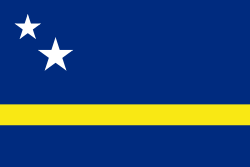
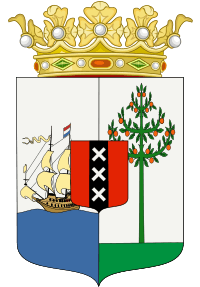
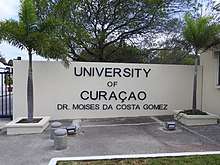
.jpg)
